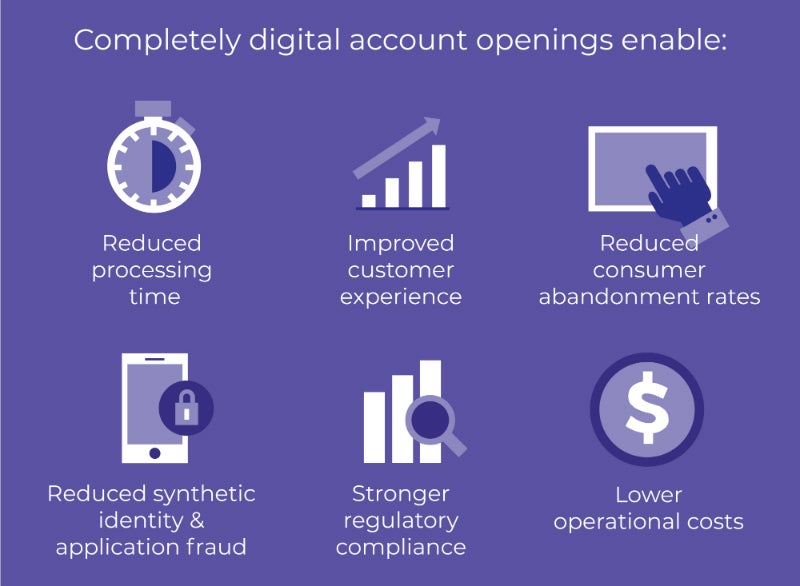
Financial institutions today are challenged with meeting consumers’ high expectations for fast and convenient digital banking processes, while also needing to mitigate fraud and comply with increasingly stringent regulatory requirements.
Consumers want to do more of their banking through digital channels. A 2018 survey of more than 5,000 consumers showed that 69% want to be able to conduct their entire financial lifecycle – from account opening to taking out personal loans – entirely through online and mobile channels. Yet, too often today, new customers are still sent out of the digital channel and forced to visit a branch location in order to complete the account opening process. A move that injects additional friction into the process and increases customer frustration.
That’s because even in today’s increasingly digital era, banks are struggling to fully digitize the account opening and onboarding process. In order to prevent application fraud and comply with strict Know Your Customer (KYC) and Anti-Money Laundering (AML) regulations, financial institutions (FIs) must positively verify their customers’ identities, which has traditionally been difficult to do in remote digital channels. Last year, it was estimated that banks alone were to exceed $31b in global fraud loss.
As a result, banks and FIs have been forced to reexamine and retool their new account opening process. As such, here are three best practices for FIs to consider when digitizing the account opening process.
Digital Identity Verification
One of the big challenges facing FIs today is achieving and maintaining the level of security without compromising the user experience. Verifying the identity of customers is an essential component of banking, where application transactions are high-value, high risk and security is of paramount importance.
The most common methods of customer identity verification methods have traditionally involved a customer visiting a branch and presenting their ID documents, or banks using legacy knowledge-based authentication (KBA) methods that cross reference the fixed identity information the customer provides against a database from third-party or credit agency.
However, as the banking landscape has shifted, and technology has advanced, both approaches are no longer adequate. The number of physical bank branches are falling, the appetite for digital banking has never been higher, and challenger banks that employ modern identity verification methods are on the rise. Given this, it’s becoming more difficult for legacy banks to justify asking customers to come in-branch to verify their identity during the account opening process.
Because KBA relies on static information that’s becoming more widely available thanks to the number of high-profile data breaches in recent years, it’s no longer a secure means of verifying identities. If cybercriminals can get their hands-on personal identifiable information (PII), then it becomes all too easy to open fraudulent accounts.
Banks need to be able to verify identities without compromising on customer experience or security. One method of doing this is by implementing context-aware identity verification, which is a combination of digital identity verification methods, such as ID document capture and facial comparison, with risk analytics.
E-signatures
Signatures are a traditional form of verifying identity, but manually “wet” signing documents can be a time-consuming and friction-filled process, that can involve visiting a branch, or printing, scanning, and posting documents, all of which carry a higher chance of human error.
The pain-points associated with manual signatures only become greater if an agreement spans geographical regions. Given this, banks are increasingly adopting e-signature solutions as a more seamless and secure e-signing experience that allows banks to acquire new customers quicker, offer a higher quality service, no matter their location.
E-signatures also help banks remain compliant with GDPR and other regulations, by capturing a customer’s digitally signed document supported by comprehensive visual audit trail detailing what the customer has agreed to, when and how they signed.
Maintaining Security & Combatting Fraud
Given the scale and impact of fraud, it is vital that FIs can detect fraud during the account opening process. As fraudsters use increasingly sophisticated methods, a rules-based fraud prevention system alone can no longer keep up. To stay ahead, FIs need an identity verification and risk-based fraud solution that leverages AI through supervised and unsupervised machine learning.
Machine learning allows organizations to analyze data with context across devices, applications, and transactions, and requires very little manual input. Machine learning algorithms analyze transaction data and only flag suspicious transactions with higher risk scores. By detecting complex risk indicator patterns that are difficult for humans and manually defined rules to identify, a risk-based analytics approach is more effective in detecting new and emerging fraud.
Digitizing the account opening process results in an improved and secure customer experience. For banks and FIs it allows them to increase application conversion rates, achieve regulatory compliance, while becoming more operationally efficient in the digital customer journey.

